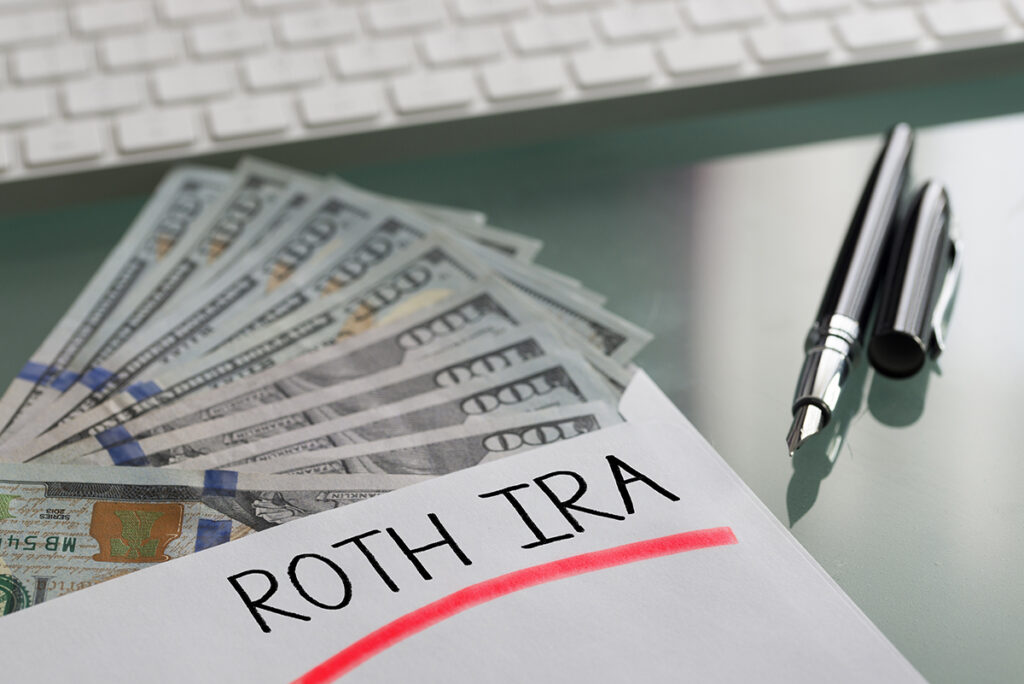YOUR WEALTH CONNECTION
March 2022

Financial Perspective on Geopolitical Landscape
Despite repeatedly denying he had any designs on his neighbor, Vladimir Putin launched an invasion of Ukraine late last month.
Conditions on the ground are quite fluid, and we won’t delve into military strategy, however, from a financial perspective, investors had been bracing for a possible invasion for much of February. We saw it in increased market volatility and a drop in the major indexes, though the decline up to the invasion was generally modest.
Since peaking on January 3, the S&P 500 Index’s peak-to-trough decline has been 11.9% (through February 23), according to S&P 500 data supplied by the St. Louis Federal Reserve.
It’s the first official correction (defined as a decline of at least 10%) since the early days of the pandemic. However, not all of the sell-off can be blamed on the Russia-Ukraine crisis. Investors are also wrestling with higher inflation and talk of higher interest rates from the Federal Reserve. But the crisis at hand has driven sentiment in recent days.
Yet strong Q4 corporate profits, according to Refinitiv, and the growing economy have cushioned the downside. It has been a powerful tailwind for investors, but not enough to overcome stiff headwinds from geopolitical uncertainty and talk of higher interest rates.
Russia makes noise before invading
Massing Russian troops along the border of Ukraine created uncertainty for investors. Analysts often say that markets despise uncertainty. We feel that the term “heightened uncertainty” may be a more accurate description, as there is always some uncertainty attached to investing.
When heightened uncertainty arises, it simply means that the number of potential outcomes for the economy is increasing. In most cases, those possible outcomes are usually negative, even if the odds of occurring are remote.
Therefore, short-term investors recalibrate and attempt to discount possible negative outcomes.
Over time, the new reality gets incorporated into the outlook and the focus returns to the domestic economy. That has been the historical pattern. In other words, historically selloffs tied to geopolitical uncertainty have been limited.
LPL Research has compiled the market reaction to 22 geopolitical “market shock events” since WWII. On average, the total drawdown was just 4.6% for the S&P 500 Index.
During the Cuban missile crisis, the S&P 500 lost 6.6% over eight days. At the time, the world appeared to be on the brink of nuclear annihilation.
The biggest decline in LPL’s survey occurred after the surprise attack on Pearl Harbor. The index shed nearly 20% in 143 days but managed to erase losses within one year of the attack.
Looking into a murky crystal ball
How the war affects the U.S. and global economy will ultimately have the biggest impact for investors. What will happen to oil prices? How might sanctions play out? Could we see cyberattacks or a wider war that involves NATO? Will the invasion rein in the Fed’s apparent impulse to boost interest rates at an aggressive pace?
These are difficult questions to answer.
At the same time, stiff sanctions against Russian banks and Russia’s Central Bank did not cause immediate tremors in U.S. markets.
“The U.S. and other Western economies have deployed a set of highly potent financial weapons against Russia with remarkable speed,” said Eswar Prasad, a Cornell University economics professor and former International Monetary Fund official.
From a financial perspective–and this is important–Russian oil and natural gas have not been sanctioned.
Stocks were priced for perfection heading into 2022. When stocks are priced for perfection and unexpected events occur, we typically see a reset.
In this case, a more hawkish-sounding Fed and Russia’s aggressive posture toward Ukraine provided the perfect pretext for short-term traders to take profits.
While we have been due for a market correction, attempting to time such a pullback is all but impossible. There are those who have been calling for a correction for over a year and found themselves watching the major stock market indexes rise to new heights.
Besides, if you want to time the market, you must be right twice to be successful—near the top and near the bottom. The smartest analysts haven’t figured out that equation. They never will.
Longer-term, the biggest influence over stocks is the U.S. economy, the Federal Reserve, and corporate profits, or what we call the economic fundamentals. How the invasion affects consumer psychology will play a big role.
Are people going to avoid dining out, or, for that matter, skip the purchase of an appliance or a planned trip? It seems unlikely.
The direct impact of Russia and Ukraine on the U.S. economy is quite limited. From December 15, 2021 to February 17, 2022, just 4% of the of S&P 500 firms that conducted earnings calls with analysts (earnings calls typically follow the release of an earnings report), cited the word “Ukraine,” according to FactSet.
By contrast, 72% of S&P 500 companies cited “inflation” over the same period.
Indirect concerns might spring from oil prices and certain commodities Russia and Ukraine export.
Control what you can control. What is happening overseas is something we cannot control.
Maintain a disciplined approach. Your financial plan helps manage emotions. It is the roadmap to your goals. It incorporates the unexpected potholes you will hit along the way toward your goals.
Just as it helps prevent you from taking on too much risk when stocks are rising at a quick pace, it also helps prevent emotional decisions that are rarely profitable when stocks are declining.
War can take ugly turns, and we are bracing for more volatility. Disappointments could send stocks lower, while positive surprises could boost equities.
We won’t pinpoint a market bottom but in the 32 times the S&P 500 Index has shed at least 10% since 1980 (excluding the current correction), one year after hitting a bottom, the index was up 24.8% on average. It was higher 90.3% of the time, according to research from LPL.
In the 13 times the S&P 500 has dropped between 10% and 15% since 1980 (excluding the current correction), the average gain from the low after one year was 21.9%. The index rose in all but one of those instances after one year.
We realize that market volatility can be frustrating. But through diversification and various measures, we take steps to help manage risk. When corrections end, the historical trends are encouraging.
We understand that news from Ukraine is very unsettling. In the face of overwhelming odds, many of us have been heartened by incredible acts of patriotism, bravery, and defiance from ordinary Ukrainian citizens. Their heroics have inspired us all.
Let’s wrap this up with a broad historical perspective from UBS analyst Art Cashin. When Art began in the business over 60 years ago, a veteran trader told him, “The world only ends once. Don’t bet on the end of the world. The odds are way against you.”
We trust you’ve found this review to be educational and helpful. If you have any questions or would like to discuss any matters, please feel free to give any Hilltop team member a call.
As always, we are honored and humbled that you have given us the opportunity to serve as your financial advisor.
Table 1: Key Index Returns
| MTD % | YTD % |
Dow Jones Industrial Average | -3.5 | -6.7 |
NASDAQ Composite | -3.4 | -12.1 |
S&P 500 Index | -3.1 | -8.2 |
Russell 2000 Index | 1.0 | -8.8 |
MSCI World ex-USA* | -1.7 | -6.1 |
MSCI Emerging Markets* | -3.1 | -4.9 |
Bloomberg US Agg Bond TR USD | -1.1 | -3.3 |
Source: Wall Street Journal, MSCI.com, MarketWatch, Morningstar
MTD returns: Jan 31, 2022—Feb 28, 2022
YTD returns: Dec 31, 2021—Feb 28, 2022
*In US dollars
Disclosure:
This presentation is not intended to be relied upon as forecast, research or investment advice, and is not a recommendation, offer or solicitation to buy or sell any securities or to adopt any investment strategy. The opinions expressed are as of the date noted and may change as subsequent conditions vary. The information and opinions contained in this letter are derived from proprietary and nonproprietary sources deemed by Hilltop Wealth Solutions to be reliable.
Additional information about Hilltop Wealth Solutions is available in its current disclosure documents, Form ADV, Form ADV Part 2A Brochure, and Client Relationship Summary Report which are accessible online via the SEC’s investment Adviser Public Disclosure (IAPD) database at www.adviserinfo.sec.gov, using SEC # 801-115255. Hilltop Wealth Solutions is neither an attorney nor an accountant, and no portion of this content should be interpreted as legal, accounting or tax advice.
How Market Cycles Can Impact Retirements
Sequence of returns can play a role in your overall portfolio.
Provided by Hilltop Wealth & Tax Solutions
A thoughtful retirement strategy may help you pursue your many retirement goals. That strategy must consider many factors, and here are just a few: your income needs, the order of your withdrawals from taxable and tax-advantaged retirement accounts, the income tax implications of those withdrawals, and sequence of return risk.
Just what is the sequence of return risk? In brief, it is the risk that market declines in the early years of retirement, combined with steady withdrawals, could reduce your portfolio’s outlook.
A recent CNBC article mentioned how sequence of return risk can affect retirement accounts. It used a 20-year example – someone retiring in 2000 with $1 million in an account tracking the returns of the S&P 500, making withdrawals of $40,000 a year that increased 2% annually in view of inflation.
In 2000, a bear market began. The 37% pullback for the S&P 500 that occurred in 2000-02 would have reduced the $1 million account to about $470,000 by January 1, 2020, the end of the 20-year period. The balance reflects the annual withdrawals of $40,000 and the 2009-20 bull market.1
Now, if the order of yearly returns were flipped, the portfolio would show much different performance. At the end of the 20-year period, the retiree would have had more than $2.3 million in that account after the exact same schedule of income distributions.1
It’s critical to point out that investing involves risk, and past performance does not guarantee future results. The return and principal value of stock prices will fluctuate as market conditions change. And shares, when sold, may be worth more or less than their original cost.
The S&P 500 Composite Index is an unmanaged index that is considered representative of the overall U.S. stock market. Individuals cannot invest directly in an index, and index performance is not indicative of the past performance of a particular investment.
In retirement, it is vital to address risk and volatility. You have less time and may have fewer opportunities to rebuild your savings. Fortunately, there are ways to address the challenge of sequence of return risk and manage your portfolio risk while looking for opportunities.
Erik Brenner, CFP® may be reached at 574.889.7526 or erikbrenner@hilltopwealthtax.com
www.HilltopWealthTax.com
This material was prepared by MarketingPro, Inc., and does not necessarily represent the views of the presenting party, nor their affiliates. This information has been derived from sources believed to be accurate. Please note – investing involves risk, and past performance is no guarantee of future results. The publisher is not engaged in rendering legal, accounting or other professional services. If assistance is needed, the reader is advised to engage the services of a competent professional. This information should not be construed as investment, tax or legal advice and may not be relied on for the purpose of avoiding any Federal tax penalty. This is neither a solicitation nor recommendation to purchase or sell any investment or insurance product or service, and should not be relied upon as such. All indices are unmanaged and are not illustrative of any particular investment.
Citations
- CNBC, January 21, 2022


Roth IRA Conversions
What are your choices? What are the benefits?
Provided by Hilltop Wealth & Tax Solutions
If you own an Individual Retirement Account (IRA), perhaps you have heard about Roth IRA conversions. Converting your traditional IRA to a Roth IRA might be a sound financial move depending on your situation.
But remember, this article is for informational purposes only, not a replacement for real-life advice. A professional should be consulted before attempting this type of strategy. Tax rules are constantly changing, and there is no guarantee that the tax treatment of Roth or Traditional IRAs will remain the same as it is now.
Also, Roth conversions have come under much scrutiny during the past few years. Congress has considered legislation that would prevent high-income Americans from Roth conversions. While no action has taken place, it is possible that Roth rules may change in the future.
Why go Roth? Every Roth IRA conversion is based on a belief: the belief that income tax rates will be higher in the future than they are now. If you hold this belief, then you may want to consider a Roth conversion.
Once you are 59½ and have had your Roth IRA open for at least five calendar years, withdrawals of the earnings from your Roth IRA are exempt from federal income taxes. In addition, once five calendar years have passed, you can withdraw your Roth IRA contributions tax-free and penalty-free.1
Under current I.R.S. rules, if you are the original owner of a Roth IRA, you never have to make mandatory withdrawals from your account. And you can make contributions to a Roth IRA as long as you continue to have earned income.2
Currently, if your federal tax filing status is married filing jointly and your adjusted gross income (AGI) is $204,000 or less, you can contribute a maximum of $6,000 to your Roth IRA, $7,000 if you’re age 50 or older. The maximum contribution is also available to single filers with an AGI of $129,000 or less. Depending on how high your AGI is, the amount you are able to contribute may change.3
Why not go Roth? There are many reasons, but here are two to consider: you have to be prepared for the taxable event and time may not be on your side.
A Roth IRA conversion cannot be undone. The I.R.S. regards it as a payout from a traditional IRA prior to that money entering a Roth IRA, and the payout represents taxable income. That taxable income stemming from the conversion could have tax consequences in the year when the conversion occurs.4
In many respects, the earlier in life you convert a regular IRA to a Roth, the better. Your income may rise as you get older; you could finish your career in a higher tax bracket than you were in when you were first employed. Those conditions relate to a key argument for going Roth: it is better to pay taxes on IRA contributions today than on IRA withdrawals tomorrow.
On the other hand, since many retirees have lower income levels than their end salaries, they may retire at a lower tax rate. That is a key argument against Roth conversion.
You could choose to “have it both ways.” As no one can reliably predict the future of American taxation, some people contribute to both Roth and traditional IRAs – figuring that they can be at least “half right” regardless of whether taxes increase or decrease.
If you do go Roth, your heirs may receive tax-free distributions. Lastly, Roth IRAs can prove to be very useful estate management tools. If I.R.S. rules are followed, Roth IRA heirs may end up with a tax-free inheritance from the account. In contrast, distributions of inherited assets from a traditional IRA are taxed.1
Under the 2019 SECURE Act, most non-spouse beneficiaries of a Roth IRA are required to have the funds distributed to them by the end of the tenth calendar year following the year of the original owner’s death.5
Erik Brenner, CFP® may be reached at 574.889.7526 or erikbrenner@hilltopwealthtax.com
www.HilltopWealthTax.com
This material was prepared by MarketingPro, Inc., and does not necessarily represent the views of the presenting party, nor their affiliates. This information has been derived from sources believed to be accurate. Please note – investing involves risk, and past performance is no guarantee of future results. The publisher is not engaged in rendering legal, accounting or other professional services. If assistance is needed, the reader is advised to engage the services of a competent professional. This information should not be construed as investment, tax or legal advice and may not be relied on for the purpose of avoiding any Federal tax penalty. This is neither a solicitation nor recommendation to purchase or sell any investment or insurance product or service, and should not be relied upon as such. All indices are unmanaged and are not illustrative of any particular investment.
Citations
1 – U.S. News, January 27, 2022
2 – Internal Revenue Service, November 27, 2021
3 – Internal Revenue Service, November 5, 2021
4 – Investopedia, February 2, 2022
5 – Forbes, December 14, 2021
Getting (Mentally) Ready to Retire
Even those who have saved millions must prepare for a lifestyle adjustment.
Provided by Hilltop Wealth & Tax Solutions
A successful retirement is not merely measured in financial terms. Even those who retire with small fortunes can face boredom or depression and the fear of drawing down their savings too fast. How can new retirees try to calm these worries?
Two factors may help: a gradual retirement transition and some guidance from a financial professional.
An abrupt break from the workplace may be unsettling. As a hypothetical example, imagine a well-paid finance manager at an auto dealership whose personal identity is closely tied to his job. His best friends are all at the dealership. He retires, and suddenly his friends and sense of purpose are absent. He finds that he has no compelling reason to leave the house, nothing to look forward to when he gets up in the morning. Guess what? He hates being retired.
On the other hand, if he prepares for retirement years in advance of his farewell party by exploring an encore career, engaging in varieties of self-employment, or volunteering, he can retire with something promising ahead of him. If he broadens the scope of his social life, so that he can see friends and family regularly and interact with both older and younger people in different settings, his retirement may also become more enjoyable.
The interests and needs of a retiree can change with age or as he or she disengages from the working world. Retired households may need to adjust their lifestyles in response to this evolution.
Practically all retirees have some financial anxiety. It relates to the fact of no longer earning a conventional paycheck. You see it in couples who have $60,000 saved for retirement; you see it in couples who have $6 million saved for retirement. Their retirement strategies are about to be tested, in real time. All that careful preparation is ready to come to fruition, but there are always unknowns.
Some retirees are afraid to spend. They fear spending too much too soon. With help from a financial professional, they can create a strategy.
Retirement challenges people in two ways. The obvious challenge is financial; the less obvious challenge is mental. Both tests may be met with sufficient foresight and dedication.
Erik Brenner, CFP® may be reached at 574.889.7526 or erikbrenner@hilltopwealthtax.com
www.HilltopWealthTax.com
This material was prepared by MarketingPro, Inc., and does not necessarily represent the views of the presenting party, nor their affiliates. This information has been derived from sources believed to be accurate. Please note – investing involves risk, and past performance is no guarantee of future results. The publisher is not engaged in rendering legal, accounting or other professional services. If assistance is needed, the reader is advised to engage the services of a competent professional. This information should not be construed as investment, tax or legal advice and may not be relied on for the purpose of avoiding any Federal tax penalty. This is neither a solicitation nor recommendation to purchase or sell any investment or insurance product or service, and should not be relied upon as such. All indices are unmanaged and are not illustrative of any particular investment.



